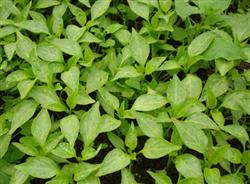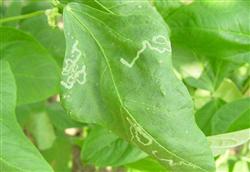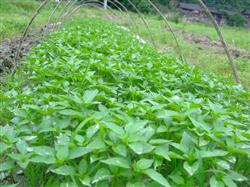What do you pay attention to in raising pepper seedlings in summer and autumn?

Summer autumn pepper seedlings pay attention to what? Please introduce summer and autumn pepper seedlings, susceptible to high temperature and rain, drought and other weather effects, seedling diseases and insect pests occur seriously. In order to ensure the normal growth of seedlings, the following measures should be taken: First, to prevent high temperature hazards, select well-ventilated plots as seedbeds, build shade sheds, cover with sunshade nets or non-woven fabrics, or use branches to shade, or spray slurry water on plastic films. After sowing, cover the seedbed with straw and remove the seedbed cover as soon as 60 -70% of the seedlings have emerged. Through shading, the temperature drops and the transmittance decreases, which is beneficial to the growth of seedlings. Second, to prevent strong wind and rainstorm harm, choose a plot with higher terrain and drainage ditch around to make seedbed, and discharge waterlogging in time in case of rainstorm. The best way to cover shade and cool down is to use the "one net and one film" covering method, that is, covering the plastic film with a sunshade net, which has a better effect of shading and cooling and preventing rainstorm than the single sunshade net. Before the rainstorm comes, the plastic film will be pulled down, the vent will be closed tightly, and the surrounding soil will be buried tightly to prevent rainwater from flowing into the seedbed. The film line will be fixed to prevent it from being blown open by strong wind. If the seedbed water, so that soil hardening, adverse seed germination unearthed, easy to cause a large number of dead seedlings. Before sowing, test the germination rate of seeds, determine the seeding amount according to the test results, sow or fully irrigate after pouring sole water in the seedbed, and then prepare the soil. Seeding water cannot use sewage or dirty water, and it is best to use groundwater. Before sowing, seedbed to shade moisture, according to weather conditions, can be sprayed in the morning or evening with a small amount of water to seedbed, prevent seedbed drought. The main reasons for preventing excessive growth of seedlings are insufficient light, weak photosynthesis, less nutrients produced, high temperature, especially high night temperature, strong respiration, more nutrients consumed, so that the dry matter content in the body is reduced, and nitrogen fertilizer and water are sufficient to promote excessive growth. In addition, seedling density is too large, mutual shielding, insufficient light, no ventilation in the seedbed, less light around the seedlings, only the top of the light, promote rapid elongation of young stems, causing excessive growth. Seedbed should not flood irrigation, only spray water with spray pot, watering amount should not be too large, keep seedbed dry and wet, and timely thinning and sub-seedlings, as long as it does not rain, shed film should be open, easy to ventilate, light transmission and moisture discharge, rainy days, remove shade, only leave plastic film rain, strive for more scattered light. 5. Prevention and control of diseases and insect pests. Under the influence of high temperature, virus diseases, aphids, cabbage pests and other diseases and insect pests are easy to occur. Fertilization should apply fully decomposed organic fertilizer, seedbeds should be disinfected with carbendazim or formaldehyde, seeds should be soaked in warm soup or treated with chemicals to avoid soil-borne diseases. After sowing, immediately spread poison bait in and around the seedbed to poison mole cricket and other underground pests, adopt the above measures to reduce the seedbed temperature, which is conducive to preventing virus diseases, select disease-resistant varieties, raise seedlings with insect nets, set up yellow and orange aphid trapping plates in the seedbed to trap aphids, and apply drugs in time. Commonly used chemicals include: 75% Chlorothalonil, 50% Carbendazim, 70% Mancozeb, 20% Virus A, 1.5% Phytopathion EC, 50% Thiram, Xinwansheng, 50% Pyrimicarb, 50% Phoxim Emulsion, 80% Trichlorfon, etc. Click for more pepper growing techniques Click for more vegetable growing techniques
- Prev

How to control Liriomyza huidobrensis by planting beans?
How to control Liriomyza huidobrensis by planting beans? Please introduce Liriomyza huidobrensis, which belongs to the genus Liriomyza huidobrensis, which mainly uses larvae to eat the sap and mesophyll between the upper and lower epidermis of plant leaves, forming nearly circular pitted maculae on the leaves, and the larvae feed on the leaves to form tunnels and tunnel curves.
- Next

What should be paid attention to in raising pepper seedlings in summer and autumn?
What should be paid attention to in raising pepper seedlings in summer and autumn? Please guide pepper seedlings in summer and autumn to pay attention to the following points: to prevent the harm of high temperature, the seedling bed should be well ventilated, sunshade should be built, sunshade should be covered with sunshade net or non-woven cloth, tree branches can also be used to shade the sun, and mud water can be sprayed on plastic film to shade the sun. After sowing, use straw.
Related
- Where is it suitable to grow horseradish in China? it is expected to see the middle altitude horseradish in Alishan.
- How to prevent tomato virus disease reasonably? (Control methods included)
- Many people like to plant towel gourd on the balcony. What are the main points of this method and management?
- What crops can chili peppers be mixed with?
- Fertilization techniques and matters needing attention in Tomato
- What are the grafting techniques for peach seedlings in spring?
- Harm and control methods of root swelling disease of Chinese cabbage
- What are the pests of sweet potatoes? How to prevent and cure it?
- Symptoms, causes and Control methods of navel Rot in Tomato
- The cause of "Cucumber rotten bibcock" in Farmers' planting Cucumber and its Control Plan

